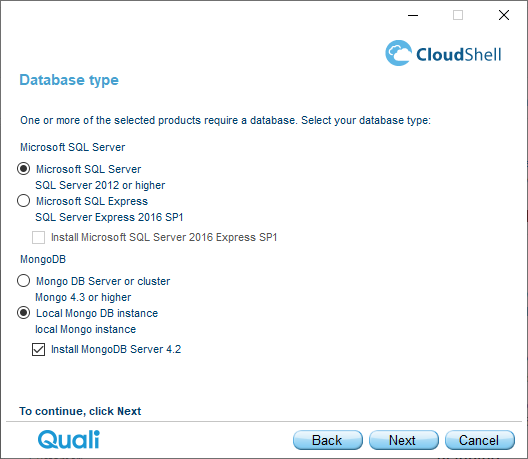Select the Database Type
CloudShell uses two databases for storing data:
- SQL Server is used like before for storing CloudShell data such as resource, user and blueprint data.
- MongoDB is used to store data related to the New Job Scheduling , including information related to suites, jobs, tests, reports as well as permitted user identity information. Starting with CloudShell 2020.2, sandbox events data is stored on MongoDB. MongoDB data will be included in Insight in future versions.
For more information, see New Job Scheduling Architecture.
-
In the Database Type window, select the database types to use with CloudShell.

-
Select the SQL Server to use.
-
Microsoft SQL Server to install CloudShell's databases on an existing SQL Server.
-
Microsoft SQL Express if you already have SQL Express 2016 SP1. If a database server is not installed or is not available from a remote machine, select the Install Microsoft SQL Server 2016 Express SP1 checkbox to allow CloudShell to install SQL Express 2016 SP1 for you.
Tip: For high load systems, we recommend using an SQL Server that is hosted on a separate machine (not Quali Server).
-
-
Select the MongoDB to use. CloudShell officially supports Mongo 4.2 and above (Community and Enterprise editions).
- If your system administrator has a centralized MongoDB instance or cluster that can be utilized for CloudShell, select the Mongo DB Server or cluster option (Supported for MongoDB 4.3 and above).
- If there is no external MongoDB, select Local MongoDB instance to enable CloudShell installer to use an existing instance of MongoDB. If you don't have an existing MongoDB instance or cluster, select Install MongoDB Server 4.2 to enable the CloudShell installer to install and configure a local MongoDB Server 4.2 instance (Community edition).
Tip: For high load systems, we recommend using a cluster/instance that is hosted on a separate machine (not Quali Server). For additional information, see Best Practices for MongoDB.
- Click Next and proceed to Set the MongoDB Connection Strings.
